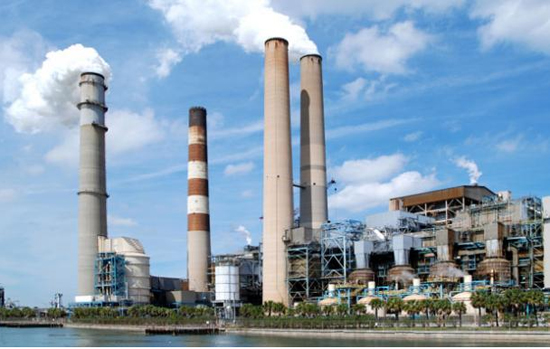Monday, Jun. 02, 2014
By Dina Cappiello and Josh Lederman
Associated Press via Fort Worth Star-Telegram
WASHINGTON — In a sweeping initiative to curb pollutants blamed for global warming, the Obama administration unveiled a plan Monday that cuts carbon dioxide emissions from power plants by nearly a third over the next 15 years, but pushes the deadline for some states to comply until long after President Barack Obama leaves office.
In Texas, the emissions would need to decline by 39 percent by 2030 under the U.S. Environmental Protection Agency’s proposed greenhouse gas reduction proposal. The agency calls for a 32.6 percent average reduction nationally compared to 2012 emission rates.
Texas would need to reduce its carbon dioxide emissions from 1,298 pounds per megawatt-hour, the rate in 2012, to 791 pounds per mw-h, according to the agency. A megawatt is about enough electricity to power 200 average Texas residences during a time of peak demand, such as a hot summer day.
EPA officials said the standards are based on the 2012 "state of the fleet" for each state’s generation capacity, taking into account previous efforts to cut emissions through energy efficiency programs, renewable energy standards and other programs. According to EPA, Texas got about half its power in 2012 from natural gas, 32 percent from coal, 7.5 percent from wind and 8.9 percent from nuclear.
"It will be up to the states to define their plans … to meet the goals," one senior EPA officials said on a conference call with reporters this morning. "Ultimately if a state doesn’t set a plan the EPA will set one," said another EPA official on the call.
It could be a carbon tax or other system, the officials said, "and states will make their own choices of what makes sense for them." The goals set by the EPA also include considerations of what alternatives are available to a state, such as the supply of natural gas to replace coal.
The 645-page rule, expected to be finalized next year, is a centerpiece of Obama’s plans to tackle climate change and aims to give the United States more leverage to prod other countries to act when negotiations on a new international treaty resume next year. Under the plan, carbon emissions would be reduced 30 percent by 2030, compared to 2005 levels, putting in motion one of the most significant actions on global warming.
The proposal sets off a complex regulatory process, steeped in politics, in which the 50 states will each determine how to meet customized targets set by the Environmental Protection Agency.
"The glue that holds this plan together – and the key to making it work – is that each state’s goal is tailored to its own circumstances, and states have the flexibility to reach their goal in whatever works best for them," said EPA Administrator Gina McCarthy, according to prepared remarks released in advance of Monday’s formal announcement. She characterized the proposal as "ambitious, but achievable."
Luminant Generation, the state’s largest power company, in a prepared release called for the EPA to "give Texas broad flexibility and sufficient time to form an implementation plan tailored to its unique regional needs." It said it would submit comments to the agency "and also work with the state to develop a workable compliance plan for Texas that doesn’t harm reliability or the economy."
"Today, we applaud President Obama and the EPA for their move to clean up our air, improve the health of our children, and curb the worst effects of climate disruption," said Scheleen Walker, director of the Lone Star Chapter of the Sierra Club. "Climate disruption and extreme weather in Texas have already cost more than five billion dollars in federal disaster relief for 2011 and 2012 alone."
Initially, Obama wanted each state to submit their plans for cutting pollution to meet the new targets by June 2016. But details of the new proposal show that states could have until 2017, and 2018 if they join with other states to tackle the problem. That means even if the rules survive legal and other challenges, the dust won’t likely settle on this transformation until well into the next administration, raising the possibility that political dynamics in either Congress or the White House could alter the rule’s course.
S. William Becker, who heads the National Association of Clean Air Agencies, said the rule gives states more time to develop strategies and gives them credit for steps they’ve already taken to cut emissions of heat-trapping greenhouse gases.
"Still, the regulatory and resource challenges that lie ahead are daunting," Becker said.
Power plants are the largest source of greenhouse gases in the U.S., accounting for about a third of the annual emissions that make the U.S. the second largest contributor to global warming on the planet.
Yet the rule carries significant political and legal risks, which were heightened by the EPA giving states beyond 2016 to submit plans. The rule has already drawn intense scorn from Republicans – and even some Democrats waging difficult campaigns this year in energy-producing states.
The policy change will further diminish the role of coal in U.S. electrical production. Coal, which once supplied about half the nation’s electricity, has dropped to 40 percent as it has been replaced by booming supplies of natural gas and renewable sources such as wind and solar.
"If these rules are allowed to go into effect, the administration for all intents and purposes is creating America’s next energy crisis," said Mike Duncan of the American Coalition for Clean Coal Electricity, which represents the coal industry. He accused the administration of "political expediency over practical reality."
Still, even with the new rules, the EPA predicted that coal and natural gas would remain the two leading sources of electricity generation in the U.S., with each providing more than 30 percent of the projected supply.
The EPA projected that carrying out the plan will cost up to $8.8 billion annually in 2030, but the actual costs will depend heavily on how states choose to reach their targets. The administration argued that any costs to comply are far outweighed by savings in health costs that the U.S. will realize thanks to reductions in other pollutants like soot and smog that will accompany a shift away from dirtier fuels.
EPA data show that the nation’s power plants have reduced carbon dioxide emissions by nearly 13 percent since 2005, or about halfway to the administration’s goal. The agency is aiming to have about 26 percent cut by 2020.
Environmental groups hailed the proposal, praising both the climate effects and the public health benefits they said would follow. Former Vice President Al Gore, a prominent environmental advocate, called it "the most important step taken to combat the climate crisis in our country’s history."
But with coal-fired power plants already beleaguered by cheap natural gas prices and other environmental regulations, experts said getting there won’t be easy. Some states will be allowed to emit more and others less, leading to an overall, nationwide reduction of 30 percent.
Options for states to meet the targets include making power plants more efficient, reducing the frequency at which coal-fired power plants supply power to the grid, and investing in more renewable, low-carbon sources of energy. States could also enhance programs aimed at reducing demand by making households and businesses more energy-efficient. Each of those categories will have a separate target tailor-made for each state.
Despite concluding in 2009 that greenhouse gases endanger human health and welfare, it has taken years for Obama’s administration to take on the nation’s fleet of power plants. Obama put them on the fast track last summer when he announced his climate action plan and a renewed commitment to climate change after the issue went dormant during his re-election campaign.
Obama has already tackled the emissions from the nation’s cars and trucks, announcing rules to reduce carbon dioxide emissions by doubling fuel economy. That standard will reduce carbon dioxide by more than 2 billion tons over the life of vehicles made in model years 2012-25. The power plant proposal will prevent about 430 million tons of carbon dioxide from reaching the atmosphere, based on the 30 percent figure and what power plants have already reduced since 2005.
Staff writer Jim Fuquay contributed to this report.
Fair Use Notice
This document contains copyrighted material whose use has not been specifically authorized by the copyright owner. SEED Coalition is making this article available in our efforts to advance understanding of ecological sustainability, human rights, economic democracy and social justice issues. We believe that this constitutes a "fair use" of the copyrighted material as provided for in section 107 of the US Copyright Law. If you wish to use this copyrighted material for purposes of your own that go beyond "fair use", you must obtain permission from the copyright owner.

 The
The 